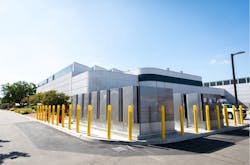Southern California Gas (SoCalGas) has begun operating microgrids at two facilities in southern California using Bloom Energy solid oxide fuel cells.
The fuel cells in the microgrids will cut greenhouse gas emissions, air pollution and power costs while boosting reliability, according to the companies.
The SoCalGas microgrids come amid a surge of microgrid development in California, partly driven by “public safety power shutoffs,” planned power outages designed to reduce wildfires. At least two million Pacific Gas & Electric customers were affected by the shutoffs last year.
SoCalGas uses solar generation at six of its 113 facilities, but the company said it opted to add fuel cells at its Monterey Park and Pico Rivera facilities because of their superior resiliency. At the Pico Rivera site SoCalGas inventories pipes and offer training. Monterey Park houses dispatch operations, IT and other back-office operations.
The 950-kV Bloom Energy Servers will provide about 90% of the electricity at the sites.
The fuel cells are configured as always-on microgrids, which eliminates the transition to backup power when there are power outages, according to Bloom. The company has deployed its fuel cells at 600 sites, and more than 85 of them are microgrids, which have powered through more than 1,500 outages.
The SoCalGas fuel cells use natural gas and oxygen to produce electricity through an electrochemical reaction. The fuel cells can also use biogas and hydrogen.
The California Air Resources Board has certified the Bloom Energy Servers as a distributed generation technology that does not require a generation permit, a designation given only to the cleanest technologies in the state, according to the companies.
The Los Angeles-based SoCalGas installed the fuel cell-based microgrids in part to support its goal of being the least polluting gas utility in the United States, according to the company. With 22 million customers, SoCalGas is the largest natural gas distribution utility in the United States.
Bloom Energy microgrid installed for SoCalGas. Photo courtesy of Bloom
Bloom Energy, based in San Jose, California, had installed fuel cells totaling 380 MW by the end of last year.
In the second quarter, Bloom Energy customers “accepted” 306 installed systems, up 12.9% from the year-ago period and a 19.5 percent jump from the first quarter.
Bloom Energy’s revenue increased last year to $785.2 million, up from $632.6 million in 2018 and $365.6 million in 2017. But in the same period, its losses climbed to $306.9 million from $273.5 million and $276.4 million.
As Bloom Energy’s fuel cells have increased in size, they have become less expensive and more efficient, according to the company. In 2011, the company made a 200-kW fuel cell that was 55% efficient and cost $11,934/kW. Last year, Bloom Energy’s 500-kW fuel cell had a 65% efficiency rating and cost $3,023/kW.
Track news about fuel cell microgrids. Subscribe to the free Microgrid Knowledge Newsletter.







